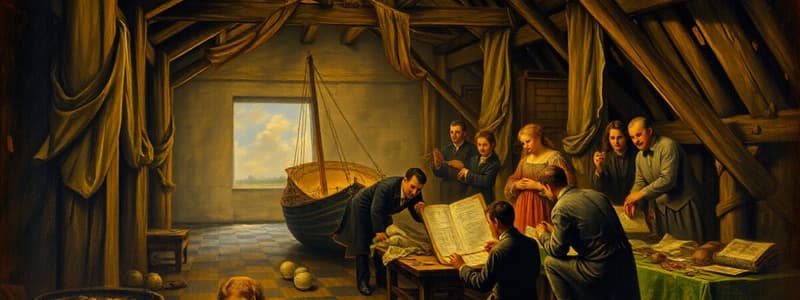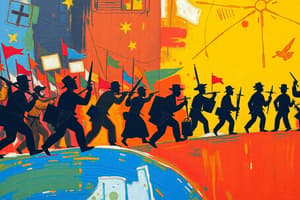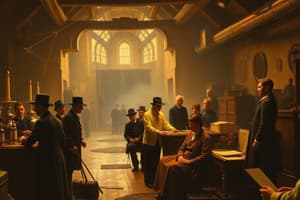Podcast
Questions and Answers
What key skill did the Civil War inadvertently teach Americans that later benefited businesses?
What key skill did the Civil War inadvertently teach Americans that later benefited businesses?
- Proficiency in battlefield tactics and military strategy.
- The art of political negotiation and compromise.
- Efficiently managing and coordinating large-scale operations. (correct)
- Advanced medical techniques for treating war wounds.
Before the Civil War, colleges primarily focused on training students for business careers.
Before the Civil War, colleges primarily focused on training students for business careers.
False (B)
What innovation became the most vital industry for transporting goods and people after the Civil War?
What innovation became the most vital industry for transporting goods and people after the Civil War?
Railroads
________, derived from petroleum, replaced whale oil as a common fuel source for lighting and machinery.
________, derived from petroleum, replaced whale oil as a common fuel source for lighting and machinery.
Match the following industries with their key figures after the Civil War:
Match the following industries with their key figures after the Civil War:
What belief did Andrew Carnegie hold regarding the responsibility of wealthy individuals?
What belief did Andrew Carnegie hold regarding the responsibility of wealthy individuals?
Government regulations aimed at preventing unethical business practices always had the intended effect of only harming wrongdoers.
Government regulations aimed at preventing unethical business practices always had the intended effect of only harming wrongdoers.
What is the term for when workers unite and refuse to work in order to demand changes?
What is the term for when workers unite and refuse to work in order to demand changes?
Workers formed ________ to collectively bargain for better pay and working conditions.
Workers formed ________ to collectively bargain for better pay and working conditions.
Match the transportation method with its primary challenge in urban centers during the period:
Match the transportation method with its primary challenge in urban centers during the period:
What material was crucial for enabling the construction of skyscrapers?
What material was crucial for enabling the construction of skyscrapers?
City machines primarily did not serve to uphold justice and moral governance in urban areas.
City machines primarily did not serve to uphold justice and moral governance in urban areas.
What term, coined by Herbert Spencer, was applied to both business and society to justify competitive success?
What term, coined by Herbert Spencer, was applied to both business and society to justify competitive success?
Christians established organizations like the YMCA and YWCA to provide alternatives to city temptations, and the ________ provided practical assistance, soup kitchens, and gospel preaching.
Christians established organizations like the YMCA and YWCA to provide alternatives to city temptations, and the ________ provided practical assistance, soup kitchens, and gospel preaching.
Match the term with its description related to living conditions in cities:
Match the term with its description related to living conditions in cities:
What was a common practice for families to instill religious values in their children?
What was a common practice for families to instill religious values in their children?
Suburbs were not primarily attractive because they did not offer more expensive housing options compared to the city.
Suburbs were not primarily attractive because they did not offer more expensive housing options compared to the city.
What new type of store, modeled after palaces, became a prominent attraction in cities, offering a variety of goods under one roof?
What new type of store, modeled after palaces, became a prominent attraction in cities, offering a variety of goods under one roof?
Farmers formed the ________ movement to advocate for laws that would benefit them, such as lower railroad and warehouse charges.
Farmers formed the ________ movement to advocate for laws that would benefit them, such as lower railroad and warehouse charges.
Match the following entities with their responses to societal changes in the late 1800s:
Match the following entities with their responses to societal changes in the late 1800s:
What was the most significant factor that transformed American's vision on business after the Civil War?
What was the most significant factor that transformed American's vision on business after the Civil War?
Workers were more likely to want to form unions when management made cuts to their own salaries to help the company succeed.
Workers were more likely to want to form unions when management made cuts to their own salaries to help the company succeed.
What was the one thing that Americans did not want to change in their community?
What was the one thing that Americans did not want to change in their community?
Andrew Canregie learned steel manufacturing tactics from _________ and his treatment of workers was often criticized.
Andrew Canregie learned steel manufacturing tactics from _________ and his treatment of workers was often criticized.
Match the following
Match the following
What did B.B. Warfield do?
What did B.B. Warfield do?
Before the Civil War, most Americans focused on working hard and therefore, did not have much leisure time.
Before the Civil War, most Americans focused on working hard and therefore, did not have much leisure time.
Who coined the phrase "survival of the fittest?"
Who coined the phrase "survival of the fittest?"
__________were often violent and could cause injuries to workers, and even death.
__________were often violent and could cause injuries to workers, and even death.
Match the best description for each one.
Match the best description for each one.
Flashcards
Post-Civil War Business Growth
Post-Civil War Business Growth
After the Civil War, businesses expanded nationally, adopting management techniques from the war effort to increase production and efficiency through mechanization.
Rise of Business Colleges
Rise of Business Colleges
After the Civil War, specialized institutions emerged, shifting away from classical education to focus on practical skills essential for success in the business world.
Railroad's Significance
Railroad's Significance
This industry became the most important in America after the Civil War, facilitating the transport of materials, goods and people across the nation.
Telegraph Lines
Telegraph Lines
Signup and view all the flashcards
Andrew Carnegie
Andrew Carnegie
Signup and view all the flashcards
John D. Rockefeller
John D. Rockefeller
Signup and view all the flashcards
Gospel of Wealth
Gospel of Wealth
Signup and view all the flashcards
Striking
Striking
Signup and view all the flashcards
Labor Unions
Labor Unions
Signup and view all the flashcards
Electric Streetcars
Electric Streetcars
Signup and view all the flashcards
Elevators
Elevators
Signup and view all the flashcards
City Machines
City Machines
Signup and view all the flashcards
Social Darwinism
Social Darwinism
Signup and view all the flashcards
Societal Problems and Christians
Societal Problems and Christians
Signup and view all the flashcards
Warfield, B. B.
Warfield, B. B.
Signup and view all the flashcards
Tenements
Tenements
Signup and view all the flashcards
Building Standards and Sewage Systems
Building Standards and Sewage Systems
Signup and view all the flashcards
Apartments and Row Houses
Apartments and Row Houses
Signup and view all the flashcards
Bible Reading and Devotions
Bible Reading and Devotions
Signup and view all the flashcards
Suburbs
Suburbs
Signup and view all the flashcards
Department Stores
Department Stores
Signup and view all the flashcards
Granger Movement
Granger Movement
Signup and view all the flashcards
Retreat Centers
Retreat Centers
Signup and view all the flashcards
Study Notes
The Civil War's Impact on Business
- The Civil War taught Americans to manage large-scale operations, which benefited businesses after the war.
- Businesses grew post-war, employing more people and expanding nationally.
- Businesses adopted Civil War management techniques to increase efficiency and profits.
- Measuring worker output became important for evaluating business success.
- Colleges started focusing on training students for business careers, emphasizing essential skills over traditional subjects.
Key Industries After the Civil War
- Railroads became the leading industry, transporting materials and people nationwide.
- The growth of railroads spurred the development of telegraph lines for instant communication.
- Steel became a major industry, with Andrew Carnegie as a leading manufacturer who learned from railroad efficiency.
- Oil became significant for lighting and machine lubrication, replacing whale oil.
- John D. Rockefeller innovated in oil refining, making kerosene affordable for widespread use.
- Industrial growth improved daily life for Americans.
- Industrial advancements were attributed to human intelligence and abilities given by God.
Wealth and Its Responsibilities
- Business growth led to immense wealth for some.
- Andrew Carnegie advocated for wealthy individuals to use their wealth to help others during their lifetime.
- Government laws were enacted to prevent businesses from misusing their power.
Working Conditions
- Employer-worker relationships changed as businesses grew larger.
- Workers faced issues like overwork, low pay, and unsafe conditions.
- Workers' wages, living conditions, and affordability of goods improved through mass production.
- Factory work was dangerous, with injured workers often losing their jobs and income.
Labor Unions
- Workers formed labor unions to collectively bargain for better conditions.
- Unions used strikes to pressure companies, sometimes leading to violence.
- Company owners sometimes used force to break up strikes, causing deaths.
- Unions could also act unjustly.
Development of City Transportation
- Early cities were small and walkable.
- Cities developed horse-drawn buses and streetcars, later replaced by electric streetcars.
- New York and Chicago used elevated trains, while Boston, New York, and Philadelphia built subways.
- Electric-powered transit reshaped urban living and work patterns.
- Businesses stayed downtown, factories were nearby, and apartments for the poor were built close to factories.
- The middle class lived farther from the center, and the wealthy lived on the edges of the city, commuting to work.
Development of Skyscrapers
- Cities grew both outward and upward, constructing taller buildings.
- Steel enabled the construction of skyscrapers over thirty stories.
- Elevators became essential for accessing upper floors.
City Problems
- Urban growth led to increased crime, fires, and infrastructure needs.
- City machines, controlling city governance, emerged to assist immigrants but were often corrupt.
- Machine leaders secured votes for power and wealth through dishonest practices.
- Machine bosses lacked virtue and governed unjustly.
Social Darwinism
- Herbert Spencer applied Darwin's evolution theories to society.
- Spencer's "survival of the fittest" opposed helping the weak, hindering progress.
- Social Darwinism clashed with Christian values.
Christian Response to Societal Problems
- Christians addressed poverty and sin, preaching the gospel and providing Christian environments.
- Organizations like YMCA and Salvation Army offered alternatives to city temptations and practical help.
- Christians focused on salvation from sin.
B. B. Warfield
- B. B. Warfield, a theology professor, defended the Bible.
Conflict and Toleration
- True Christians defended the Bible and opposed liberalism.
- Some favored toleration, but liberals later excluded Christians from churches.
Poverty and Tenement Conditions
- The poorest lived in overcrowded tenements with poor water supply, were poorly constructed, and became slums.
- Disease spread rapidly, and drunkenness was a major problem.
Building Standards and Sewage Systems Improvement
- Building standards were introduced in New York City to improve safety
- Cities started improving sewage systems to maintain a clean water supply
- Newspapers emphasized personal cleanliness and good diets
Living in Neighborhoods
- Those who were not poor lived in their own neighborhoods, either within the city or in suburbs
- Many people could not afford to buy houses in the city and instead rented apartments or row houses
- Apartments are sets of rooms within a building that can be rented
- Row houses are houses built in a row without space between them
- Compared to tenements, apartments and row houses in the 1870s were better constructed and had indoor plumbing with hot and cold water
- Gas or electric lights allowed people to stay up later and read
Bible Reading and Christian Devotions
- Families often read the Bible together
- Many homes had designated spaces for displaying the family Bible, and families practiced Christian devotions
- Children learned the catechism, a book of questions and answers used to teach about God and the Bible
Suburbs as a City Escape
- Some people preferred living in the suburbs where land was cheaper.
- More people could afford to buy houses in the suburbs.
- Living in the suburbs was considered healthier and reminiscent of small-town life.
- Suburbs provided more space for children to play.
- The suburbs served as an escape from the city while still being close enough for men to commute to work via streetcars.
Department Stores as New Attraction
- Department stores were a new attraction in cities.
- Before department stores, people had to visit multiple stores to find what they needed.
- Department stores were large stores divided into different sections, such as clothing, dry goods, toys, or furniture.
- Modeled after palaces, department stores were very fancy, featuring restaurants and sitting areas to encourage shoppers to stay all day.
Introduction
- As America grew, many Americans lived and worked in rural areas, initially welcoming changes that promised prosperity for their farms and towns.
Challenges for Rural Businesses
- City businesses often had lower costs for goods and shipping compared to small-town businesses.
- Small-town residents could order goods from city businesses and have them shipped by train, increasing choices and lowering costs.
- Small-town businesses struggled to compete with larger city businesses.
Farmers' Difficulties
- Farmers faced increased competition due to railroads that allowed crops to be shipped to more places.
- Industrial progress enabled farmers to grow more food, leading to an oversupply and lower prices.
- Farmers who had borrowed money for seed or equipment struggled to repay their debts due to reduced profits.
- Expenses included the cost of transporting goods via railroads and storing them in warehouses.
- Buildings where farmers stored grain were called granges, and the farmers were known as grangers.
The Granger Movement
- Farmers formed the Granger movement to advocate for laws that favored them.
- They sought government intervention to lower railroad and warehouse charges.
- They also wanted the government to print more paper money.
- Most of these ideas did not become law, as they were not considered beneficial for the nation as a whole.
Resistance to Urban Improvements
- Rural Americans questioned the need for hard-surface roads desired by city dwellers, as they maintained their own roads.
- Farmers resisted attempts to change the one-room schoolhouse and opposed the introduction of grades.
- They wanted to maintain control over their children's education, focusing on reading, writing, and math.
Changes in Leisure Time
- Americans had more leisure time outside of work and church, in both urban and rural areas.
- Entertainment began to replace church and volunteer work, raising concerns among some Christians.
Retreat Centers
- Some Christians established retreat centers, similar to camps, offering fun activities along with Bible studies, sermons, and prayer meetings.
- These centers provided opportunities for activities like hiking, boating, and concerts while keeping faith at the center.
Conclusion
- The late 1800s were marked by growth and the establishment of businesses that laid the foundation for American success.
- Cities offered opportunities but also faced challenges like crime and corruption.
- Christians faced challenges from false teachers but continued to help those in need and evangelize.
- The era presented both challenges and opportunities, with God blessing Americans with growth and expansion.
- Americans needed to ensure that their growth aligned with God's will.
Studying That Suits You
Use AI to generate personalized quizzes and flashcards to suit your learning preferences.



